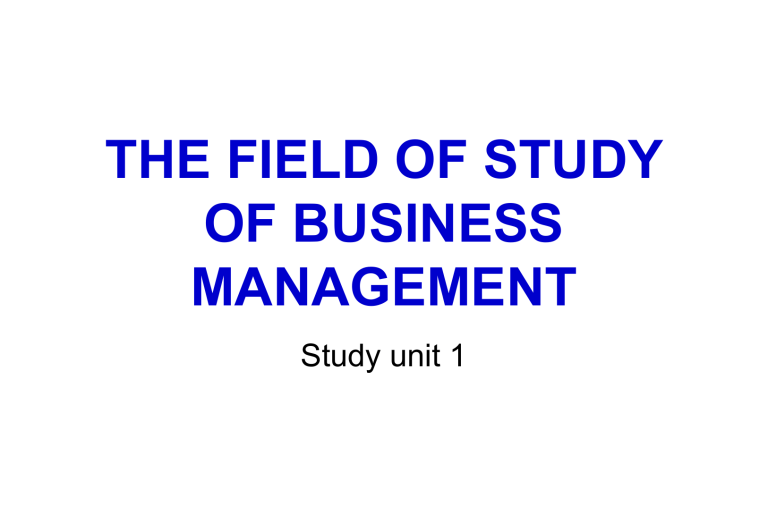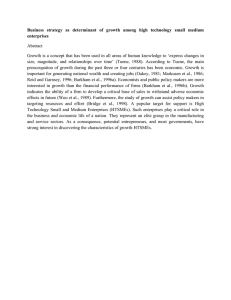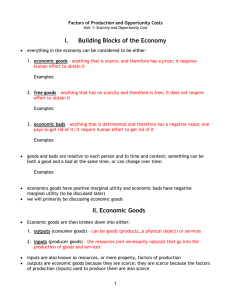THE FIELD OF STUDY OF BUSINESS MANAGEMENT Study unit 1

THE FIELD OF STUDY
OF BUSINESS
MANAGEMENT
Study unit 1
LECTURE OUTLINE
1 INTRODUCTION
2 NEED SATISFACTION
3 BUSINESS MANAGEMENT FIELD OF STUDY
4 BUSINESS ENTERPRISE AND OPERATING UNIT
5 BUSINESS MANAGEMENT AS A SCIENCE
6 BUSINESS MANAGEMENT VE ECONOMICS
7 FACTORS OF PRODUCTION
8 FUNCTIONAL APPROACH
9 SYSTEMS APPROACH
10 STUDY UNIT REVIEW
11 APPLICATION QUESTIONS
2
INTRODUCTION
Primary field of study: establishment and management of businesses
Business Management: principles by which businesses are managed to achieve objectives successfully
Entrepreneurs driving force behind economic progress businesses = firms = enterprises
NEED SATISFACTION
Motive drive satisfying needs
Maslow’s hierarchy of needs
3
NEED SATISFACTION
To satisfy needs: scarce resources required
Scarce resources = factors of production (FOP)
Businesses perform conversion processes to create products and services from these four factors of production: inputs outputs
Economic problem: unlimited/various needs BUT limited/scarce resources (FOP)
Economic motive: the drive to satisfy needs by acquiring products and services
Economic principle: (how is this to be done) to achieve the highest possible output of products and services to satisfy needs by using the lowest possible inputs (scarce FOP/ limited resources)
Minimise input ; maximise output
4
BUSINESS MANAGEMENT – FIELD OF STUDY
Business management as a science
Free market system and profit motive
What a business is
How a business is established and managed
The role of entrepreneurs in establishing and managing a business in the free market system
The business functions performed in an enterprise to deliver the required products and services to customers
5
BUSINESS ENTERPRISE AND OPERATING UNIT
ENTERPRISE
independent economic entity
legal entity for certain forms of business enterprises
continuity
own decisions
accepts risks, uncertainty, rapid change
profitable use of factors of production
remunerates factors of production
uses operating unit to achieve goals and objectives
TYPES OF ENTERPRISES
Private enterprises, public corporations, non-profit enterprises
6
BUSINESS ENTERPRISE VS OPERATING UNIT
OPERATING UNIT
physical, visible production unit
transformation (conversion) process takes place
production of products and provision of services
found in every economic system
in free market system its survival depends on business enterprise
not just a factory, may be a shop, store, warehouse, bank branch, restaurant, etc.
7
BUSINESS ENTERPRISE VS OPERATING UNIT
PLANT
HUMAN ELEMENT
OPERATING UNIT (ESTABLISHMENT)
ALL OTHER BUSINESS FUNCTIONS
ENTERPRISE
8
BUSINESS MANAGEMENT AS A SCIENCE
body of knowledge
proved through observation, experimentation and/or logical argument
theories not yet proven wrong
theories formulated in Business Management relate to the establishment and management of businesses
object of study/empirical object
Q: what is observed/studied?
A: business enterprise and its operating unit(s)
problem statement/angle of investigation/cognitive object
Q: what is the angle of investigation/viewpoint to be researched?
A: maximisation of the rate of return on capital invested
applied/practical science
normative science – providing guidelines/principles
9
Economic principle re-stated:
To achieve the greatest economic return
(income) with the lowest possible means of production (cost)
10
BUSINESS MANAGEMENT VS ECONOMICS
BUSINESS MANAGEMENT ECONOMICS
Private business enterprises concerned about customer need satisfaction and pursuit of rate of return through means of production, eg., income generation of enterprise and its operating unit
Problem statement:
Economic principle
Concerned about need satisfaction in the national economy as a whole, eg., income generation, income distribution and income expenditure for the economy as a whole
Problem statement:
Economic principle
Object of study: business enterprises – establishment and management
Object of study: total economy – economic phenomena
Smaller field of study: mainly concerned about economic processes within an enterprise 11
FACTORS OF PRODCUTION/SCARCE RESOURCES (4)
Natural resources: occur naturally in earth’s environment land including agriculture, minerals, forests, wind/water energy, fruits of the sea
Human resources: physical and mental effort workforce and working population
Capital: ownership of the enterprise’s assets machinery, equipment, funds
Entrepreneurship: driving force bear all the risks, enjoy all the spoils
12
SYSTEMS APPROACH
The systems approach assumes that all businesses comprises of interdependent parts that can only be understood by reference to the whole. As such, a business may be analysed in terms of inputs, processes and outputs.
synergetic principle
open or closed
every effort to achieve objective(s)
all systems are subsystems
open systems more complex
13





